Nursery Rhymes
- A physician’s point of view
Lionel WIJESIRI
WHEN asked to recall childhood memories, very few of any of us, would
not include the wonderful nursery rhymes we were able to recite long
before we could read or write. These rhymes have stayed with us
throughout the years. We have inherited them from our grandparents and
will continue to pass them on to
|
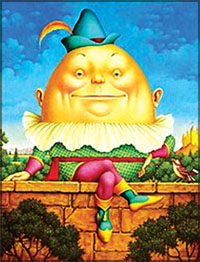
Humpty Dumpty sat on a wall
|
future generations
The history of nursery rhyme dates back centuries, to a time when
written language was scarce or limited to the highly educated gentry.
A study by Iona and Peter Opie, presented in The Oxford Dictionary of
Nursery Rhymes indicates that “at least one quarter, and very likely one
half of the rhymes are more than 200 years old.
It was due to the lack of written material, and more importantly the
lack of education for the working class that the rhymes which we now
refer to as nursery rhymes were passed on by word of mouth.
However, nursery rhymes are often recited to children, but little
thought is given to their content. Recent studies show that several
popular nursery rhymes portray head and body injuries as inevitable
events that do not require medical follow-up.
A light-hearted physician had this much to say about those nursery
rhymes. “I found six rhymes in which head injury was mentioned or
suggested: Humpty Dumpty, Jack and Jill, Hush-a-bye-baby, Ten Little
Monkeys, It’s Raining - It’s Pouring and Ring Around the Rosie. No
single category appears to have been spared injury. Babies, teenagers,
old men, primates, non-gendered, nondescript characters - everyone
suffered”.
In the case of Humpty Dumpty, we have to question whether “all the
king’s horses and all the king’s men”
|
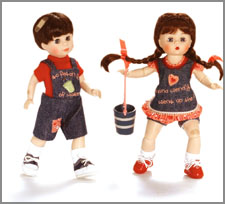
Jack and Jill
|
were capable of launching an appropriate medical intervention after
Mr. Dumpty’s unfortunate accident. What sort of emergency training and
equipment did these first responders have? Maybe the accompanying
saddlebags might have contained a cervical collar.
However, it is unlikely that a spinal board would have been
available, seriously compromising spinal management. The presence of
“all the king’s men” also suggests a shocking lack of crowd control.
It is elementary in first-aid control. Could the crowded scene
explain the inability of the responders to “put Humpty together again”?
Maybe a good EMS personnel could have saved the victim?
The infant in “Hush-a-bye-baby” must have sustained great trauma
after falling to the ground “when the bough broke,” but medical
attention does not seem to have been sought. If it was, it was not
documented. But why was this infant in the tree in the first place?
Child Protective Services should have been called to interrogate the
child’s guardian, who was obviously failing to provide a safe
environment.
Sadly, there is no reference to any complaint being filed against the
child’s caregiver, nor of any effort to treat the unfortunate child.
There are obvious parallels between events described in
“Hush-a-bye-baby” and “Ten Little Monkeys.” The latter begins with 10
monkeys jumping on a bed. By its end, none is jumping. Why? Might each
monkey have acquired a significant head or spinal injury while jumping
on the bed, and therefore been left unable to perform
|
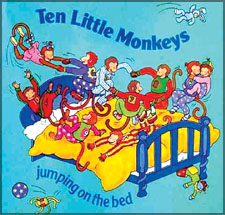
Ten Little Monkeys
|
this activity?
Although Mama did the right thing by calling “the doctor,” it is
clear that no examination of the injured monkeys was conducted. Indeed,
the doctor’s only advice, which was presumably offered over the phone,
was that there should be “no more monkeys jumping on the bed.”
The Medical Council has consistently warned against dispensing this
type of medical advice over the phone. The physician in this case would
have been wise to follow that advice and to have visited the house in
question - perhaps nine tragedies could have been avoided.
At least, he could have advised the mother to take the monkey to the
Accident Ward. This rhyme is yet another example of the need for strong
legislation to protect members of our society who are at risk. After the
first incident, the monkeys should have been placed in foster care.
“Jack and Jill” offers a unique glimpse into an incident involving
adolescent victims, but the description of their injuries leaves much to
be desired. It is difficult to ascertain the extent of Jack’s injury.
Does a broken “crown” refer to a skull fracture? The use of this term
reminds readers that colloquial expressions can detract from a patient’s
future care and that appropriate medical terminology should be used
whenever possible.
And the injuries that Jill sustained when she “came tumbling after”
are not documented. Is this yet another
|
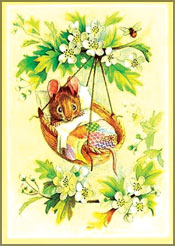
Rock a Bye Baby
|
case of medical discourse excluding women?
The case of the “old man” who “went to bed and bumped his head and
couldn’t get up in the morning” that is documented in “It’s Raining -
It’s Pouring” is worthy of a Crime Scene Investigation or (in police
jargon) CSI.
There are two versions. The first version is presented above, but the
second one changes the sequence of events so that the old man “bumped
his head” then “went to bed.”
Obviously, establishing the exact sequence of events is crucial to
the creation of a differential clinical diagnosis. If the elderly
gentleman bumped his head after retiring for the evening, one is forced
to entertain potential foul play, seizure activity or even a Myocardial
Infarction (in medical jargon MI).
There is no evidence to confirm the commonly held belief that he was
alone. Also, it should be noted that he was “snoring.” Could his death
have been precipitated by severe obstructive sleep apnea?
If he actually bumped his head before going to sleep, the list of
potential mechanisms is endless, and a good forensic investigation is
required to determine the cause of death. The notoriously poor
documentation of factors precipitating head injury in nursery rhymes
makes it impossible to determine what really happened in this case as
well as others.
“Ring around the Rosie” supposedly tells the tale of young children
living during the infamous Black Plague. Depending on the version, the
words “Ashes, ashes” or “Ahusha, ahusha” precede “They all fall down.”
It is absurd to think that a pneumonic process could take an entire
group of children from the joyous noise of a game to the silence of
death this quickly. Clearly, something happened that led to physical -
and probably cranial - disaster.
We hypothesize that an earthquake or faulty decking caused the
children to experience head trauma
|
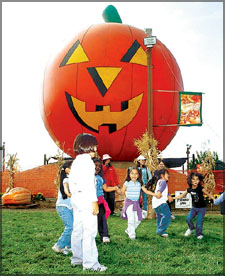
Ring Around the Rosie
|
simultaneously, and this explains why the poem ends so
abruptly. Again, the lack of a clear history and the use of colloquial
terms make it impossible to determine what actually happened
Regardless of the malevolent words in some of them, the nursery
rhymes that were popular years ago, and still are today, can in fact be
placed in the category of child entertainment.
As was just stated by the Medical Doctor, some of them were far from
soothing but rather may have been sung to intimidate the child and/or
used as an outlet for the emotions of the parent or nurse.
Whatever the reason, the evolution of the nursery rhyme has taken
place over countless years. The rhymes have been able to survive vast
changes in both political structure, technological advances, and of
course changes in literary styles and demands. |

